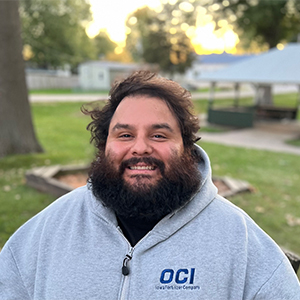During the early morning hours of a recent weekday at OCI Nitrogen, a 306-acre nitrogen production and distribution facility in in the southeast corner of Iowa, a handful of employees with different job functions and backgrounds came together seamlessly to help one of their own.
As they do each day, the night and day shifts meet in the Central Control Room to review completed tasks and identify goals for the incoming shift. At 5:30 a.m., while the teams conferred about the day’s tasks, team members noticed that 33-year-old Joshua Prado suddenly appeared listless and confused. When he slumped back in his chair, his coworkers kept him from crashing to the floor and field operator Connor McMillen quickly activated the OCI Nitrogen internal emergency response team and dialed 911 for Lee County EMS.
From rehearsal to reality
Operational buyer Brianna Wolf, lab technician Taylor Thompson, and reliability engineer Austin Kemper are all volunteers on the OCI Nitrogen Emergency Response Team. As soon the call for assistance came over the two-way radio, they dropped everything and ran to the Health and Safety Building. Brianna and Austin grabbed supplies and took the on-site emergency response vehicle across the campus to the Central Control Room while Taylor and safety employees Dan Turner and Sammie Jones took OCI Nitrogen’s on-site ambulance.
Plant operators directed the volunteers to Joshua. They found him unresponsive and reclined in a chair. “My coworkers kept me from hitting the floor when I collapsed,” Joshua later explained. While they checked his pulse, he suddenly began making loud snoring sounds and then stopped breathing altogether.
AED guidance focuses team efforts
Safety specialist Dan Turner recognized the sound of agonal breathing and suspected sudden cardiac arrest (SCA). He yelled for someone to grab the automated external defibrillator (AED) kept nearby. Austin, Brianna , and other safety team members cleared a space for the group to safely lower Joshua to the floor. Brianna then turned her attention to reassuring bystanders and clearing the room. Just then, Joshua lost his pulse.
“A lot of people think they’ll never have to use an AED. But it’s important to know where they are. And when you do need it, it tells you step-by-step what to do.”
— Joshua Prado,
OCI Nitrogen employee and SCA survivor
Scott Bleything, Joshua’s coworker and childhood friend, ran for the ZOLL® AED Plus® defibrillator. Taylor used shears to quickly cut open Joshua’s shirt while Austin turned on the ZOLL AED and employee Jeff Deacon affixed the electrodes to Joshua’s bare chest. Taylor quickly began cardiopulmonary resuscitation (CPR).
Within moments, the AED analyzed Joshua’s heart rhythm, advised the first of nearly 20 shocks he would need that day, and audibly warned rescuers to stand clear.
Taylor resumed CPR following the first shock. Connor took over CPR after the second shock, and Austin took a turn delivering CPR after the third. In all, Joshua received three defibrillating shocks before Lee County EMS paramedics arrived at OCI Nitrogen.
An inspired recovery
Joshua began showing signs of consciousness shortly after receiving a third shock. “He began to wake up, make noises, and even tried to speak,” explains Brianna.
When Lee County EMS arrived, Joshua was awake and asking questions. After confirming his vital signs were stable and heart rhythm was normal, paramedics transported him to a local hospital. “I have faint memories of being in an ambulance,” Joshua recalls. He was transferred to University of Iowa hospital where, later that evening, he went into SCA a second time. “My heart rate started going crazy and they had to continue to shock me for 2 hours. Eventually they sedated me for a day and a half to give my heart rhythm a chance to stabilize,” explains Joshua.
During his week stay, Joshua received an implantable cardioverter-defibrillator (ICD) to detect and correct any future heart arrhythmias. “The doctors say I have a healthy heart. It’s hard to understand that they might not be able to figure out what happened,” explains Joshua.
Preparedness lessens bystander anxiety, improves care

This was the first time some of these volunteers assisted with an AED and CPR. “Of course, tensions were high, emotions were high,” recalls Brianna. “The thought of losing a coworker is gut-wrenching; however, the team never once stumbled,” she adds. Switching out compressors throughout CPR delivery helped ensure that CPR quality wasn’t impacted by rescuer fatigue.
Following Joshua’s SCA, OCI Nitrogen corporate representatives emailed employees to commend them for knowing where the ZOLL AED was located and remind them of the locations of other AEDs around the campus. “A lot of people think they’ll never have to use an AED. But it’s important to know where they are. And when you do need it, it tells you step-by-step what to do,” explains Joshua.
Doctors suggest that Joshua’s positive outcome is attributable to OCI Nitrogen’s well-organized group of volunteer responders and AEDs situated across campus. “All of my doctors said that the response of the volunteer emergency team and my coworkers, along with the fact that they used an AED on me, was why I survived,” Joshua explains. “I’m alive because this group jumped into action. I will be forever grateful.”



